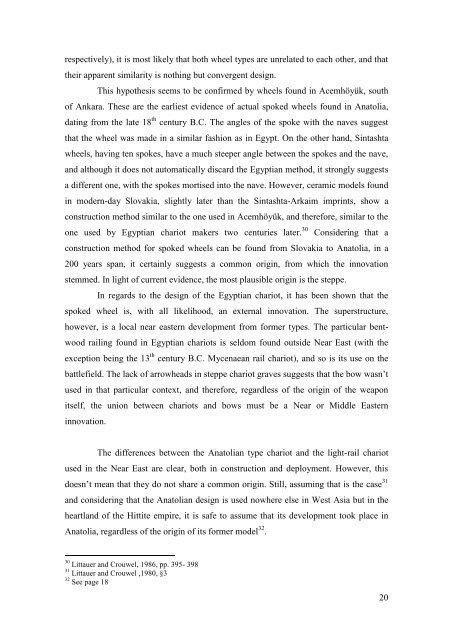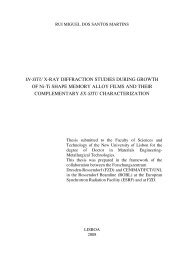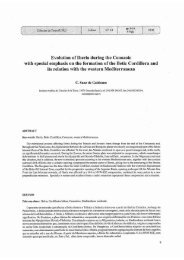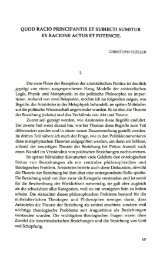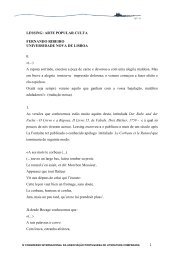Elias Manuel Morgado Pinheiro Dissertação de Mestrado em ...
Elias Manuel Morgado Pinheiro Dissertação de Mestrado em ...
Elias Manuel Morgado Pinheiro Dissertação de Mestrado em ...
Create successful ePaper yourself
Turn your PDF publications into a flip-book with our unique Google optimized e-Paper software.
espectively), it is most likely that both wheel types are unrelated to each other, and that<br />
their apparent similarity is nothing but convergent <strong>de</strong>sign.<br />
This hypothesis se<strong>em</strong>s to be confirmed by wheels found in Ac<strong>em</strong>höyük, south<br />
of Ankara. These are the earliest evi<strong>de</strong>nce of actual spoked wheels found in Anatolia,<br />
dating from the late 18 th century B.C. The angles of the spoke with the naves suggest<br />
that the wheel was ma<strong>de</strong> in a similar fashion as in Egypt. On the other hand, Sintashta<br />
wheels, having ten spokes, have a much steeper angle between the spokes and the nave,<br />
and although it does not automatically discard the Egyptian method, it strongly suggests<br />
a different one, with the spokes mortised into the nave. However, ceramic mo<strong>de</strong>ls found<br />
in mo<strong>de</strong>rn-day Slovakia, slightly later than the Sintashta-Arkaim imprints, show a<br />
construction method similar to the one used in Ac<strong>em</strong>höyük, and therefore, similar to the<br />
one used by Egyptian chariot makers two centuries later. 30 Consi<strong>de</strong>ring that a<br />
construction method for spoked wheels can be found from Slovakia to Anatolia, in a<br />
200 years span, it certainly suggests a common origin, from which the innovation<br />
st<strong>em</strong>med. In light of current evi<strong>de</strong>nce, the most plausible origin is the steppe.<br />
In regards to the <strong>de</strong>sign of the Egyptian chariot, it has been shown that the<br />
spoked wheel is, with all likelihood, an external innovation. The superstructure,<br />
however, is a local near eastern <strong>de</strong>velopment from former types. The particular bent-<br />
wood railing found in Egyptian chariots is seldom found outsi<strong>de</strong> Near East (with the<br />
exception being the 13 th century B.C. Mycenaean rail chariot), and so is its use on the<br />
battlefield. The lack of arrowheads in steppe chariot graves suggests that the bow wasn‟t<br />
used in that particular context, and therefore, regardless of the origin of the weapon<br />
itself, the union between chariots and bows must be a Near or Middle Eastern<br />
innovation.<br />
The differences between the Anatolian type chariot and the light-rail chariot<br />
used in the Near East are clear, both in construction and <strong>de</strong>ployment. However, this<br />
doesn‟t mean that they do not share a common origin. Still, assuming that is the case 31<br />
and consi<strong>de</strong>ring that the Anatolian <strong>de</strong>sign is used nowhere else in West Asia but in the<br />
heartland of the Hittite <strong>em</strong>pire, it is safe to assume that its <strong>de</strong>velopment took place in<br />
Anatolia, regardless of the origin of its former mo<strong>de</strong>l 32 .<br />
30 Littauer and Crouwel, 1986, pp. 395- 398<br />
31 Littauer and Crouwel ,1980, §3<br />
32 See page 18<br />
20


